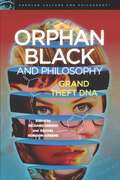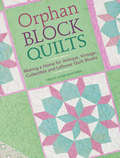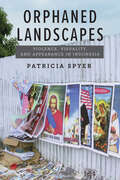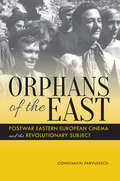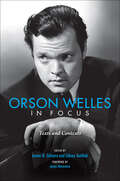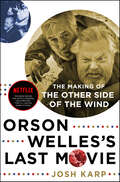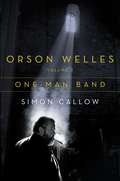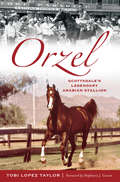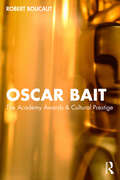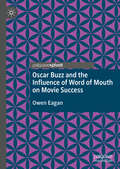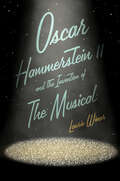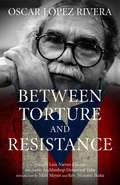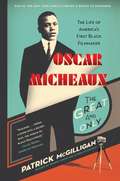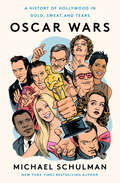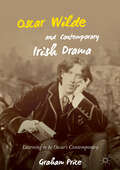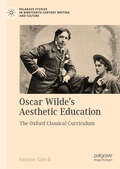- Table View
- List View
Orphan Black and Philosophy
by Richard Greene Rachel Robison-GreeneIn Orphan Black, several apparently unconnected women discover that they are exact physical doubles, that there are more of them out there, that they are all illegally produced clones, and that someone is having them killed. They find themselves in the midst of a secret and violent struggle between a fundamentalist religious group, a fanatical cult of superhuman biological enhancement, a clandestine department of the military, and a giant biotech corporation. Law enforcement is powerless and easily manipulated by these sinister forces. The clones are forced to form their own Clone Club, led by the resourceful Sarah Manning, to defend themselves against their numerous enemies and to find out exactly where they came from and why. <p><p> Orphan Black continually raises philosophical issues, as well as ethical and policy questions deserving philosophical analysis. What makes a person a unique individual? Why is it so important for us to know where we came from? Should we have a say in whether a clone is made of us? Is it immoral to generate clones with built-in health problems or personality defects - and if so, does that mean that producers of clones must practice eugenic selection? What light does the behavior of members of the Clone Club shed on the nature-nurture debate? Is it relevant that most are heterosexual, one is a lesbian, and one is a transgender male? <p> This TV show shows us problems of biotechnology which will soon be vital everyday issues. But what kind of a future faces us when human clones are commonplace? Will groups of human clones have a tight bond of solidarity making them a threat to democracy? If the world is going to be taken over by an evil conspiracy, would it better be a scientific cult like Neolution or a religious cult like the Prolethians? Should biotech corporations be able to own the copyright on human DNA sequences? What rules of morality apply when you can't trust the police and powerful groups are ready to murder you?
Orphan Block Quilts: Making a Home for Antique, Vintage, Collectible and Leftover Quilt Blocks
by Tricia Lynn MaloneyMake a home for your orphaned blocks!Orphaned blocks can find their way into any quilter's life. Whether they are leftover from an unfinished project, collectible blocks found at a garage sale, or even antique blocks discovered in your great-aunt's attic, Tricia Lynn Maloney will teach you how to care for your orphan blocks, and make a home for them.Orphan Block Quilts includes: *14 projects, with 11 variations. From full-size bed quilts to table runners, these projects incorporate blocks from the 1880s to the 1950s.*Instructions on caring for your orphan blocks. Find out about the common problems you might encounter with your orphans, and how to work with them.*Advice on designing a setting. Not only does Tricia provide guidance on creating companions blocks and finding companion fabric, she also offers insight on how she overcame the design challenges of each project. *The story behind each quilt. In addition to historical information about various fabrics and blocks, Tricia shares the stories of two of the blockmakers, providing a precious glimpse of the lives sewn into the seams of the blocks. If you don't have any orphan blocks, Tricia gives you advice on locating potential sources, whether from your own family or online. And it's easy to substitute brand-new blocks, and make a new quilt from the ground up. Check out the 11 variations in the book, where Tricia did just that! Whether your orphan blocks are antique, vintage, collectible or simply leftover from a recent project, you can sew the perfect setting that will let the blocks shine!
Orphan, Agent, Prima, Pawn
by Elizabeth KiemThe Bolshoi Saga: SvetlanaThe year is 1958, and sixteen-year-old Svetlana is stuck in a Moscow orphanage designated for the unwanted children of Stalin’s enemies. Ballet is her obsession and salvation, her only hope at shedding a tainted family past. When she is invited to join the Bolshoi Ballet—the crown jewel of Russian culture and the pride of the Soviet Union—her dreams appear to have been realized. But she quickly learns that nobody’s past or secrets are safe.The dreaded KGB knows about the mysterious trances Sveta has suffered, inexplicable episodes that seem to offer glimpses of the past. Some very powerful people believe Sveta is capable of serving the regime as more than a ballerina, and they wish to recruit her to spy on the West as part of the nascent Soviet psychic warfare program. If she is to erase the sins of her family, if she is to dance on the world stage for the Motherland—if she is to survive—she has no choice but to explore her other gift.
Orphaned Landscapes: Violence, Visuality, and Appearance in Indonesia
by Patricia SpyerLess than a year after the end of authoritarian rule in 1998, huge images of Jesus Christ and other Christian scenes proliferated on walls and billboards around a provincial town in eastern Indonesia where conflict had arisen between Muslims and Christians. A manifestation of the extreme perception that emerged amid uncertainty and the challenge to seeing brought on by urban warfare, the street paintings erected by Protestant motorbike-taxi drivers signaled a radical departure from the aniconic tradition of the old colonial church, a desire to be seen and recognized by political authorities from Jakarta to the UN and European Union, an aim to reinstate the Christian look of a city in the face of the country’s widespread islamicization, and an opening to a more intimate relationship to the divine through the bringing-into-vision of the Christian god.Stridently assertive, these affectively charged mediations of religion, masculinity, Christian privilege and subjectivity are among the myriad ephemera of war, from rumors, graffiti, incendiary pamphlets, and Video CDs, to Peace Provocateur text-messages and children’s reconciliation drawings. Orphaned Landscapes theorizes the production of monumental street art and other visual media as part of a wider work on appearance in which ordinary people, wittingly or unwittingly, refigure the aesthetic forms and sensory environment of their urban surroundings. The book offers a rich, nuanced account of a place in crisis, while also showing how the work on appearance, far from epiphenomenal, is inherent to sociopolitical change. Whether considering the emergence and disappearance of street art or the atmospherics and fog of war, Spyer demonstrates the importance of an attunement to elusive, ephemeral phenomena for their palpable and varying effects in the world.Orphaned Landscapes: Violence, Visuality, and Appearance in Indonesia is available from the publisher on an open-access basis.
Orphans of the East: Postwar Eastern European Cinema And The Revolutionary Subject
by Constantin ParvulescuUnlike the benevolent orphan found in Charlie Chaplin's The Kid or the sentimentalized figure of Little Orphan Annie, the orphan in postwar Eastern European cinema takes on a more politically fraught role, embodying the tensions of individuals struggling to recover from war and grappling with an unknown future under Soviet rule. By exploring films produced in postwar Hungary, the German Democratic Republic, Czechoslovakia, Romania, and Poland, Parvulescu traces the way in which cinema envisioned and debated the condition of the post-World War II subject and the "new man" of Soviet-style communism. In these films, the orphan becomes a cinematic trope that interrogates socialist visions of ideological institutionalization and re-education and stands as a silent critic of the system's shortcomings or as a resilient spirit who has resisted capture by the political apparatus of the new state.
Orson Welles in Focus: Texts and Contexts
by James Naremore Sidney Gottlieb James N. GilmoreThrough his radio and film works, such as The War of the Worlds and Citizen Kane, Orson Welles became a household name in the United States. Yet Welles’s multifaceted career went beyond these classic titles and included lesser-known but nonetheless important contributions to television, theater, newspaper columns, and political activism. Orson Welles in Focus: Texts and Contexts examines neglected areas of Welles’s work, shedding light on aspects of his art that have been eclipsed by a narrow focus on his films. By positioning Welles’s work during a critical period of his activity (the mid-1930s through the 1950s) in its larger cultural, political, aesthetic, and industrial contexts, the contributors to this volume examine how he participated in and helped to shape modern media. This exploration of Welles in his totality illuminates and expands our perception of his contributions that continue to resonate today.
Orson Welles in Focus: Texts and Contexts
by James N. Gilmore and Sidney Gottlieb“A wonderful and distinct addition to the Welles canon . . . these pieces explore key elements of Welles’s career, personality, and political beliefs.” —Library JournalThrough his radio and film works, such as The War of the Worlds and Citizen Kane, Orson Welles became a household name in the United States. Yet Welles’s multifaceted career went beyond these classic titles and included lesser-known but nonetheless important contributions to television, theater, newspaper columns, and political activism. Orson Welles in Focus: Texts and Contexts examines neglected areas of Welles’s work, shedding light on aspects of his art that have been eclipsed by a narrow focus on his films. By positioning Welles’s work during a critical period of his activity (the mid-1930s through the 1950s) in its larger cultural, political, aesthetic, and industrial contexts, the contributors to this volume examine how he participated in and helped to shape modern media. This exploration of Welles in his totalityilluminates and expands our perception of his contributions that continue to resonate today.“Anyone who thinks they know Welles will have their eyes opened [by this book].” —Paul Heyer, author of The Medium and the Magician“This is a fascinating collection, several of the contributions making the reader wish for more.” —Film International“A team of scholars has examined the many facets of Orson Welles’ amazing life—theatrical innovator, radio star, celebrated filmmaker, newspaper columnist and progressive activist.” —Wellesnet
Orson Welles's Last Movie: The Making of The Other Side of the Wind
by Josh KarpJournalist Josh Karp shines a spotlight on the making of The Other Side of the Wind—the final unfinished film from the auteur of Citizen Kane in Orson Welles’s Last Movie, the basis of Oscar-winning director Morgan Neville’s Netflix Original Documentary, They’ll Love Me When I’m Dead.In the summer of 1970, legendary but self-destructive director Orson Welles returned to Hollywood from years of self-imposed exile in Europe and decided it was time to make a comeback movie. Coincidentally, it was the story of a legendary self-destructive director who returns to Hollywood from years of self-imposed exile in Europe. Welles swore it wasn’t autobiographical.The Other Side of the Wind was supposed to take place during a single day, and Welles planned to shoot it in eight weeks. It took six years during his lifetime—only to be finally completed more than thirty years after his death by The Last Picture Show director Peter Bogdanovich, who narrates the film, and released by Netflix. Orson Welles’s Last Movie is a fast-paced, behind-the-scenes account of the bizarre, hilarious, and remarkable making of what has been called “the greatest home movie that no one has ever seen.” Funded by the shah of Iran’s brother-in-law, and based on a script that Welles rewrote every night for years, the film was a final attempt to one-up his own best work. It’s a production best encompassed by its star—the celebrated director of The Maltese Falcon, John Huston—who described the making of the film as “an adventure shared by desperate men that finally came to nothing.”
Orson Welles, Volume 3: One-Man Band
by Simon CallowThe third volume of Simon Callow's acclaimed Orson Welles biography, covering the period of his exile from America (1947-1964), when he produced some of his greatest works, including Touch of EvilIn One-Man Band, the third volume in his epic and all-inclusive four-volume survey of Orson Welles's life and work, the celebrated British actor Simon Callow again probes in comprehensive and penetrating detail into one of the most complex, contradictory artists of the twentieth century, whose glorious triumphs (and occasional spectacular failures) in film, radio, theater, and television introduced a radical and original approach that opened up new directions in the arts. This volume begins with Welles's self-exile from America, and his realization that he could function only to his own satisfaction as an independent film maker, a one-man band, in fact, which committed him to a perpetual cycle of money raising. By 1964, he had filmed Othello, which took three years to complete; Mr. Arkadin, the most puzzling film in his output; and a masterpiece in another genre, Touch of Evil, which marked his one return to Hollywood, and like all too many of his films was wrested from his grasp and reedited. Along the way he made inroads into the fledgling medium of television and a number of stage plays, of which his 1955 London Moby-Dick is considered by theater historians to be one of the seminal productions of the century. His private life was as spectacularly complex and dramatic as his professional life. The book reveals what it was like to be around Welles, and, with an intricacy and precision rarely attempted before, what it was like to be him, answering the riddle that has long fascinated film scholars and lovers alike: Whatever happened to Orson Welles?
Orthodox by Design: Judaism, Print Politics, and the ArtScroll Revolution
by Jeremy StolowOrthodox by Design, a groundbreaking exploration of religion and media, examines ArtScroll, the world's largest Orthodox Jewish publishing house, purveyor of handsomely designed editions of sacred texts and a major cultural force in contemporary Jewish public life. In the first in-depth study of the ArtScroll revolution, Jeremy Stolow traces the ubiquity of ArtScroll books in local retail markets, synagogues, libraries, and the lives of ordinary users. Synthesizing field research conducted in three local Jewish scenes where ArtScroll books have had an impact--Toronto, London, and New York--along with close readings of key ArtScroll texts, promotional materials, and the Jewish blogosphere, he shows how the use of these books reflects a broader cultural shift in the authority and public influence of Orthodox Judaism. Playing with the concept of design, Stolow's study also outlines a fresh theoretical approach to print culture and illuminates how evolving technologies, material forms, and styles of mediated communication contribute to new patterns of religious identification, practice, and power.Finalist for the National Jewish Book Award in the scholarship category, Jewish Book Council
Orzel: Scottsdale's Legendary Arabian Stallion (Sports)
by Stephanie J. Corum Tobi Lopez TaylorIn 1967, Scottsdale's longtime Arabian horse breeder Ed Tweed embarked on a mission to race the horses he bred. He imported a chestnut stallion from Poland named Orzel, or "Eagle" in English, that flew past competitors to become the first U.S. National Racing Champion. Among other wins in halter and performance, Orzel was the victor in the debut of the U.S. National Championship Ladies' Sidesaddle category, partnered with Tweed's granddaughter Shelley Groom Trevor. Thousands of fans visited the legendary performer in retirement at Brusally Ranch. Decades after Orzel's death, horses he sired continue his winning legacy. Author Tobi Lopez Taylor chronicles this triumphant story.
Os Dez Melhores Filmes De James Bond... De Todos Os Tempos! #10: 007 Contra a Chantagem Atômica
by Mark WilliamsOs Dez Melhores Filmes De James Bond... De Todos Os Tempos? Não poderia ser mais subjetivo que isto. Ou mais divertido! Venha se juntar ao autor de best-sellers internacionais Mark Williams em uma odisseia de James Bond enquanto ele explora o fenômeno James Bond, neste quinquagésimo aniversário do lançamento do filme de James Bond que entra em décimo lugar na lista: 007 Contra a Chantagem Atômica.
Osborn, The (Images of America)
by Andrew F. Horn Mark R. Zwerger Janet M. MalangOn opening day of The Osborn, Tuesday, April 21, 1908, 12 elderly gentlewomen stepped down from horse-drawn carriages and into a new life, a life that happened because of the vision of one remarkablewoman: Miriam Osborn. Seven years later, the first recorded history of the institution noted, ,"Every effort has been made to make this institution the finest in the world, and not only a fine institutionbut a real home.," Polished by the sands of time, the modern Osborn has sustained that world-class status as one of the nation,'s premier retirement communities. This volume celebrates those who preserved not so much a way of life but a philosophy of caring and a commitment to provide a real home that has endured for 100 years.
Oscar Bait: The Academy Awards & Cultural Prestige (Routledge Advances in Film Studies)
by Robert BoucautThe Academy Awards – or "the Oscars" – have held a unique position in defining and enacting "prestige" for film industries and their publics. In evaluating ‘the best’ of film, they wield cultural influence over such cinema practices as consumption and evaluation, filmmaking aesthetics and narratives, and the discursive activity of Hollywood’s industrial agents and audiences. Oscar Bait: The Academy Awards & Cultural Prestige offers a comprehensive insight into how a film or star positions one’s self as a viable competitor worthy of such consecration in new media contexts.Based over three years of ‘Oscars seasons’ (2019–2021), rigorous analysis of film texts, awards telecasts, and circulating discursive media is built through an original scholarly framework for understanding modern cultural awards. Oscar Bait recontextualises the Oscars’ complex legacy into a new media ecosystem, one in which their established value is undercut by declining broadcast viewership, the changing values and demands of global film publics, and influential discourses aiming to progress popular culture beyond its problematic histories. In this new paradigm of film production and consumption, Boucaut explores what the Oscars mean in a contemporary filmmaking landscape and what impacts established stereotypes of Oscar-worthiness – the colloquial ‘Oscar Bait’ – continue to hold over the awards.Oscar Bait captures a dynamic snapshot of the Oscars and Hollywood in a critical era. It advances popular culture scholarship by developing an analytical framework for understanding disparate media texts within an awards season – and it critically updates Oscars knowledges for modern contexts. Readers interested in media and cultural studies, celebrity studies, persona studies, popular culture, and film will enjoy this book.
Oscar Buzz and the Influence of Word of Mouth on Movie Success
by Owen EaganThis book explores why word of mouth is the most important determinant of a movie’s success. Beginning with a discussion of the enduring appeal of movies, and why the box office has survived the disruption of television and will likely survive the disruption of streaming services, Owen Eagan goes on to discuss the unpredictable nature of movies and ways to mitigate their risk. His astute analysis sheds light on the role of film festivals, film critics, Oscar campaigns, and word of mouth in influencing a film's success. Eagan concludes with a summary of why word of mouth is the most influential among all the variables that affect a film’s outcome. Expertly synthesizing quantitative analyses of box office data with illuminating insights from industry experts, this concise and engaging book presents findings with important implications for scholars, industry insiders and marketing professionals alike.
Oscar Faber's Reinforced Concrete
by John G Faber F.H. MeadThis E. & F. N. Spon title is now distributed by Routledge in the US and Canada. It contains detailed coverage of the basic theory of reinforced and prestressed concrete, and demonstrates a wide range of practical applications. Examples and diagrams are used extensively throughout for ease of understanding.
Oscar Hammerstein II and the Invention of the Musical
by Laurie WinerA new look at artist Oscar Hammerstein II as a pivotal and underestimated force in the creation of modern American culture You know his work—Show Boat, Oklahoma!, Carousel, The King and I. But you don’t really know Oscar Hammerstein II, the man who, more than anyone else, invented the American musical. Among the most commercially successful artists of his time, he was a fighter for social justice who constantly prodded his audiences to be better than they were. Diving deep into Hammerstein’s life, examining his papers and his lyrics, critic Laurie Winer shows how he orchestrated a collective reimagining of America, urging it forward with a subtly progressive vision of the relationship between country and city, rich and poor, America and the rest of the world. His rejection of bitterness, his openness to strangers, and his optimistic humor shaped not only the musical but the American dream itself. His vision can continue to be a touchstone to this day.
Oscar López Rivera: Between Torture and Resistance
by Desmond Tutu Matt Meyer Osacar Lopez Rivera Luis Nieves Falcón Nozomi Ikuta<p>The life story of Puerto Rican freedom fighter and leader Oscar López Rivera, outlined in this book, is one of courage, valor, and sacrifice. In 1981, Oscar was convicted of seditious conspiracy and other crimes for which he is still imprisoned, making him the longest-held political prisoner in the world. This is the story of his fight for the political independence of Puerto Rico based on letters between him and the renowned lawyer, sociologist, educator, and activist Luis Nieves Falcón. <p>Also included is Oscar’s art, including photography and paintings created in his many years behind bars. Readers will explore his early life as a Latino child growing up in the small towns of Puerto Rico, following him as an adolescent as he and his family move to the big cities of the United States. After serving in Vietnam and earning a Bronze Star, Oscar returned home and worked to improve the quality of life for his people by becoming a community activist, which led to his underground life as a Puerto Rican Nationalist and his subsequent arrest. <p>With a vivid assessment of the ongoing colonial relationship between the United States and Puerto Rico, the book helps to illustrate the sad tale of largely unreported human rights abuses for political prisoners in the United States, but it is also a story of hope and his ongoing struggle for freedom for his people and himself—a hope that there is beauty and strength in resistance.</p>
Oscar Micheaux and His Circle
by Pearl Bowser Jane Gaines Charles MusserOscar Micheaux--the most prolific African American filmmaker to date and a filmmaking giant of the silent period--has finally found his rightful place in film history. Both artist and showman, Micheaux stirred controversy in his time as he confronted issues such as lynching, miscegenation, peonage and white supremacy, passing, and corruption among black clergymen. In this important collection, prominent scholars examine Micheaux's surviving silent films, his fellow producers of race films who alternately challenged or emulated his methods, and the cultural activities that surrounded and sustained these achievements. The relationship between black film and both the stage (particularly the Lafayette Players) and the black press, issues of underdevelopment, and a genealogy of Micheaux scholarship, as well as extensive and more accurate filmographies, give a richly textured portrait of this era. The essays will fascinate the general public as well as scholars in the fields of film studies, cultural studies, and African American history. This thoroughly readable collection is a superb reference work lavishly illustrated with rare photographs.
Oscar Micheaux: The Great and Only
by Patrick McgilliganOscar Micheaux was the Jackie Robinson of film, the black D. W. Griffith: a bigger-than-life American folk hero whose important life story is nearly forgotten today. Now, in a feat of historical investigation and vivid storytelling, one of our greatest film biographers takes on one of the most talented and complex figures in the history of American entertainment. The son of freed slaves, Micheaux grew up in Metropolis, Illinois, then roamed America as a Pullman porter before making his first mark as a homesteader in South Dakota. Disaster and defeat there led him to forge a career publishing a successful series of autobiographical novels. Ever the entrepreneur, when Hollywood failed to bid high enough for film rights to his stories, he answered by forming his own film production company. Going on to produce or direct twenty-two silent and fifteen sound films in his lifetime, Micheaux became the king of the "race cinema" industry at a time when black-produced films had to scrounge for venues in a segregated society. In this groundbreaking new biography, award-winning film historian Patrick McGilligan offers a vivid and fascinating portrait of this little-known pioneer. Part visionary, part raffish Barnum-like showman, Micheaux was both a maverick filmmaker and an inveterate hustler who used every weapon at his disposal to break the color barrier and thrive in a profession he helped to invent. He made a fortune and lost it again, and launched repeated con games that were followed by public arrests and bankruptcies. He eagerly took credit for the work of others-including his unsung-heroine wife. In his desperate later years, he even sunk to plagiarizing his final novel-a discovery McGilligan reveals here for the first time. In this searching exploration, McGilligan tracks down long-lost financial records, unpublished letters, and unmarked pauper's graves, pinpointing Micheaux's birthplace, his tangled personal life, and the circumstances of his tragic death. The result is an epic that bridges a fascinating period in American history, and offers lessons for anyone who would understand the role of black America in forming the culture of our time.
Oscar Wars: A History of Hollywood in Gold, Sweat, and Tears
by Michael SchulmanThe author of the New York Times bestseller Her Again: Becoming Meryl Streep returns with a lively history of the Academy Awards, focusing on the brutal battles, the starry rivalries, and the colorful behind-the-scenes drama.America does not have royalty. It has the Academy Awards. For nine decades, perfectly coiffed starlets, debonair leading men, and producers with gold in their eyes have chased the elusive Oscar. What began as an industry banquet in 1929 has now exploded into a hallowed ceremony, complete with red carpets, envelopes, and little gold men. But don’t be fooled by the pomp: the Oscars, more than anything, are a battlefield, where the history of Hollywood—and of America itself—unfolds in dramas large and small. The road to the Oscars may be golden, but it’s paved in blood, sweat, and broken hearts.In Oscar Wars, Michael Schulman chronicles the remarkable, sprawling history of the Academy Awards and the personal dramas—some iconic, others never-before-revealed—that have played out on the stage and off camera. Unlike other books on the subject, each chapter takes a deep dive into a particular year, conflict, or even category that tells a larger story of cultural change, from Louis B. Mayer to Moonlight. Schulman examines how the red carpet runs through contested turf, and the victors aren't always as clear as the names drawn from envelopes. Caught in the crossfire are people: their thwarted ambitions, their artistic epiphanies, their messy collaborations, their dreams fulfilled or dashed.Featuring a star-studded cast of some of the most powerful Hollywood players of today and yesterday, as well as outsiders who stormed the palace gates, this captivating history is a collection of revelatory tales, each representing a turning point for the Academy, for the movies, or for the culture at large.
Oscar Wilde and Contemporary Irish Drama: Learning to be Oscar's Contemporary
by Graham PriceThis book is about the Wildean aesthetic in contemporary Irish drama. Through elucidating a discernible Wildean strand in the plays of Brian Friel, Tom Murphy, Thomas Kilroy, Marina Carr and Frank McGuinness, it demonstrates that Oscar Wilde's importance to Ireland's theatrical canon is equal to that of W. B. Yeats, J. M. Synge and Samuel Beckett. The study examines key areas of the Wildean aesthetic: his aestheticizing of experience via language and self-conscious performance; the notion of the dandy in Wildean texts and how such a figure is engaged with in today's dramas; and how his contribution to the concept of a ‘verbal theatre’ has influenced his dramatic successors. It is of particular pertinence to academics and postgraduate students in the fields of Irish drama and Irish literature, and for those interested in the work of Oscar Wilde, Brian Friel, Tom Murphy, Thomas Kilroy, Marina Carr and Frank McGuinness.
Oscar Wilde's Aesthetic Education: The Oxford Classical Curriculum (Palgrave Studies in Nineteenth-Century Writing and Culture)
by Leanne GrechThis book focuses on the role that the Oxford classical curriculum has had in shaping Oscar Wilde’s aestheticism. It positions Wilde as a classically trained intellectual and outlines the path he took to gain recognition as a writer and promoter of the aesthetic movement. This narrative is conveyed through a broad range of literary sources, including Wilde’s travel poetry, American lectures, and canonical works like ‘The Critic as Artist’, The Soul of Man, The Picture of Dorian Gray and De Profundis. This study proposes that Wilde approached aestheticism as a personalised, self-directed learning experience – a mode of self-culture – which could be used to maintain an intellectual life outside of the university. It also explores Wilde’s thoughts on education and considers the significance of male friendship at Oxford, and in Wilde’s life and literature.
Oscar Wilde's Last Stand: Decadence, Conspiracy, and the Most Outrageous Trial of the Century
by Philip HoareA New York Times Notable Book of the Year that Sir Ian McKellen called "a shocking tale of heroes and villains-illuminating and upsetting in equal measure.”The first production of Oscar Wilde’s Salomé in 1918, with American exotic dancer Maud Allan dancing lead, ignited a firestorm in London spearheaded by Noel Pemberton Billing, a member of Parliament and self-appointed guardian of family values. Billing attacked Allan in the right-wing newspaper Vigilante as a member of the "Cult of the Clitoris,” a feminine version of the "Cult of the Wilde,” a catchall for the degeneracy and perversion he was convinced had infected the land. He claimed that a black book was in the hands of their enemies the Germans, a book that contained the names of thousands of the British establishment who without doubt were members of the cult. Threat of exposure was costing England the war.Allan sued Billing for libel, and the ensuing trial, brought to life in this authoritative, spellbinding book, held the world in thrall. Was there or was there not a black book? What names did it contain? The trial was both hugely entertaining and deadly serious and raised specters of hysteria, homophobia, and paranoia that, like Oscar Wilde himself, continue to haunt us. As in Wilde’s own trial in 1895, libel was hardly the issue; the fight was for control over the country’s moral compass. In Oscar Wilde’s Last Stand, biographer and historian Philip Hoare gives us the full drama of the Billing trial, gavel to gavel, and brings to life this unique, bizarre, and fascinating event.Skyhorse Publishing, as well as our Arcade imprint, are proud to publish a broad range of books for readers interested in history--books about World War II, the Third Reich, Hitler and his henchmen, the JFK assassination, conspiracies, the American Civil War, the American Revolution, gladiators, Vikings, ancient Rome, medieval times, the old West, and much more. While not every title we publish becomes a New York Times bestseller or a national bestseller, we are committed to books on subjects that are sometimes overlooked and to authors whose work might not otherwise find a home.
Oscar of the Waldorf
by Karl SchriftgiesserThe present volume is the biography of Oscar Tschirky (1866-1943), known throughout the world as Oscar of the Waldorf, who worked as maître d’hôtel of the Waldorf Astoria Hotel in New York City from 1893 to 1943. The book contains many recollections devoted to the Waldorf Astoria Hotel and its founder, George C. Boldt, and his wife, Louise Kehrer Boldt.Richly illustrated throughout with black and white photographs.
